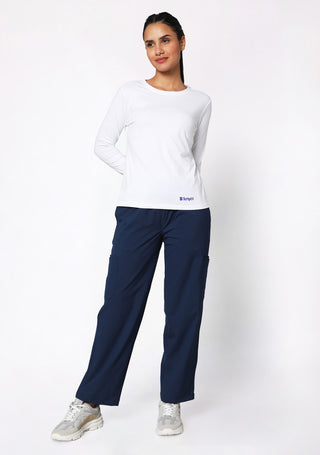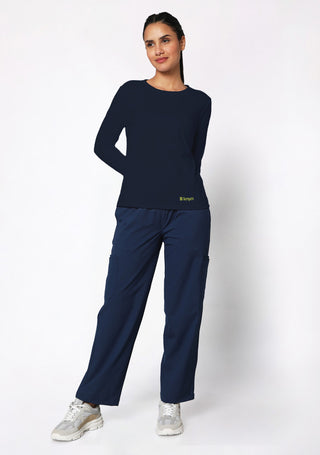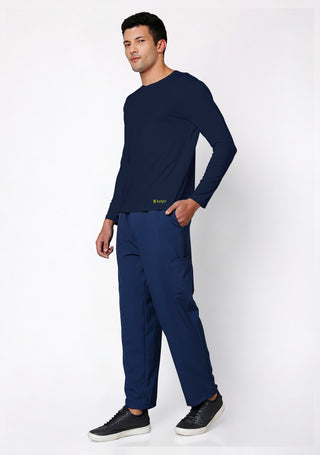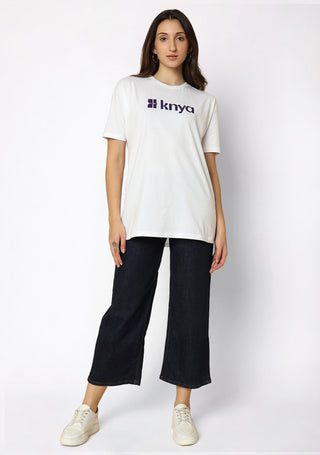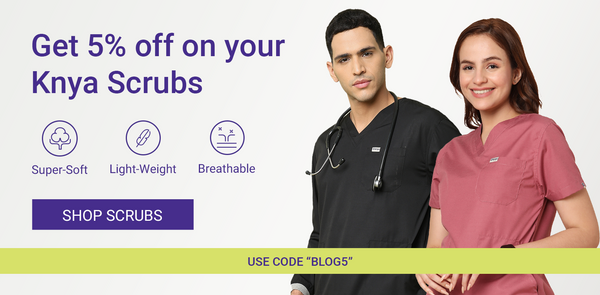Medical scrubs, lab coats, and other healthcare uniforms play a vital role in the daily lives of healthcare professionals. When it comes to choosing the right fabric for medical apparel, comfort and durability are key considerations. Yet, many wonder why scrubs are typically not made from cotton, despite its reputation for softness and breathability. While cotton is commonly used in everyday wear, it is not the ideal choice for healthcare environments. In this blog, we will explore why cotton is avoided for scrubs, the best alternatives, and why brands like Knya prioritize quality fabrics for medical professionals.
Ready to explore our amazing scrubs collection? Browse the best here
Why Cotton Isn’t the Best Choice for Scrubs?
While cotton remains a popular fabric for casual clothing, it has several drawbacks that make it less suitable for healthcare settings. Let’s break down the main reasons why scrubs are not made from cotton:
1. Absorption and Moisture Retention
Cotton is known for its moisture-absorbing qualities. While this is beneficial for everyday wear, it becomes a significant disadvantage in medical environments. In hospitals and clinics, spills, sweat, and bodily fluids are common, and cotton holds onto moisture rather than wicking it away. This creates a breeding ground for bacteria and unpleasant odors.
In contrast, polyester, poly-viscose blends, and other synthetic materials used in scrubs are designed to wick moisture away from the body, keeping healthcare professionals dry and comfortable throughout long shifts.
2. Slow Drying Time
Due to its high absorbency, cotton takes longer to dry compared to synthetic fabrics. In a fast-paced healthcare environment, where quick turnaround times are essential for maintaining hygiene standards, slow-drying cotton can increase the risk of bacterial growth and hinder the cleaning process of medical attire.
Polyester and poly-viscose blends, on the other hand, dry quickly, making them much more practical for the fast-paced nature of medical work.
3. Wrinkling
Another significant downside of cotton is its tendency to wrinkle. Medical professionals need to maintain a neat and professional appearance, and constant wrinkling can detract from this. Cotton scrubs require frequent ironing to maintain a crisp look, which is not ideal for those working long, busy hours.
Synthetic fabrics, like polyester and poly-viscose, are wrinkle-resistant, which means healthcare workers can focus on their patients instead of worrying about their uniform's appearance.
4. Color Fading
Cotton fabrics are prone to fading after repeated washing and exposure to harsh detergents. For medical professionals who need to maintain a clean, professional appearance, faded cotton scrubs can undermine the desired look.
Synthetic fabrics, such as polyester and poly-viscose, retain their color over time, ensuring that scrubs remain vibrant and fresh after numerous washes.
The Best Fabrics for Medical Scrubs and Uniforms
Given the challenges associated with cotton, healthcare professionals require fabrics that offer superior performance in terms of durability, comfort, and appearance. Let’s explore the best fabric choices for scrubs and medical attire.
1. Polyester: A Durable and Practical Choice
Polyester is a synthetic fabric that is widely used in medical uniforms. Known for its durability, polyester offers several advantages:
-
Moisture-Wicking: Polyester draws moisture away from the body, ensuring that healthcare professionals stay dry and comfortable during long shifts.
-
Quick Drying: Unlike cotton, polyester dries quickly, reducing the risk of bacterial growth.
-
Wrinkle Resistance: Polyester scrubs remain smooth throughout the day, even after multiple washes.
-
Color Retention: Polyester maintains its vibrant colors, even after numerous washes, ensuring that medical professionals always look polished.
At Knya, our scrubs are made from high-quality polyester blends to ensure that medical professionals can rely on their uniforms to meet the demands of their job.
2. Poly-Viscose Blends: The Ultimate Combination of Comfort and Durability
Poly-viscose blends combine the durability of polyester with the softness of viscose, a semi-synthetic fabric made from cellulose. These blends offer several benefits:
-
Moisture-Wicking: Poly-viscose fabrics are excellent at drawing moisture away from the skin, keeping healthcare professionals dry and comfortable throughout their shifts.
-
Quick Drying: Poly-viscose fabrics dry much faster than cotton, which is essential in busy healthcare environments.
-
Durability: Poly-viscose is highly resistant to wear and tear, making it an excellent choice for medical uniforms that require frequent washing.
-
Wrinkle Resistance: This fabric resists wrinkling, which is essential for maintaining a professional appearance throughout the day.
-
Color Retention: Poly-viscose retains its vibrant color, ensuring that your scrubs look fresh and professional even after multiple washes.
At Knya, all of our scrubs are crafted from poly-viscose blends to provide the highest standards of durability, comfort, and style for healthcare professionals.
3. Spandex: Flexibility and Comfort
Spandex, also known as elastane or Lycra, is a stretchy fabric that is often blended into medical scrubs. Its inclusion adds flexibility and enhances comfort, allowing healthcare professionals to move freely and easily during long shifts. This is especially important for those who need to perform a wide range of tasks in a physically demanding environment.
4. Tencel (Lyocell): Eco-Friendly and Soft
Tencel, also known as lyocell, is a sustainable fabric made from wood pulp. It is a breathable, moisture-wicking, and soft material, making it a great choice for medical scrubs. Tencel is also gentle on the skin, making it ideal for those with sensitive skin.
Click here to ExploreAll Women's Scrubs and discover our complete collection of comfortable and stylish medical apparel
Why Poly-Viscose Blends Stand Out for Scrubs?
Among the many fabric options for medical uniforms, poly-viscose blends stand out for several reasons:
-
Moisture-Wicking: Poly-viscose keeps healthcare workers dry by pulling moisture away from the skin, preventing discomfort and skin issues.
-
Quick Drying: Unlike cotton, poly-viscose dries quickly, making it a more hygienic option in medical environments.
-
Durability: Poly-viscose fabrics can withstand frequent washing without losing their integrity or shape.
-
Wrinkle Resistance: This fabric maintains a professional appearance throughout the day, with minimal maintenance required.
- Affordability: Poly-viscose offers an affordable alternative for medical institutions looking to provide durable and high-quality uniforms for their staff.
At Knya, we prioritize poly-viscose blends in our scrubs to ensure the highest level of comfort and performance for healthcare professionals.





